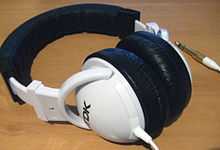Noise-cancelling headphones

Noise-cancelling headphones are headphones that reduce unwanted ambient sounds using active noise control engineering.
Noise cancellation makes it possible to enjoy music without raising the volume excessively. It can also help a passenger sleep in a noisy vehicle such as an airliner. In the aviation environment, noise cancelling headphones increase the signal-to-noise ratio significantly more than passive noise attenuating headphones or no headphones, making hearing important information such as safety announcements easier.[1] Noise-cancelling headphones can improve listening enough to completely offset the effect of a distracting concurrent activity.[2]
Noise-cancelling headphones use active noise control to cancel the lower-frequency portions of the noise; they depend on more traditional methods such as soundproofing to prevent higher-frequency noise from reaching the ear. This approach is preferred because it reduces the demand for complicated electronic circuitry that would be required for noise cancellation at higher frequencies, where active cancellation is less effective.[3] To truly cancel high frequency components (coming at the ear from all directions), the sensor and emitter for the cancelling waveform would have to be adjacent to the user's eardrum, which is not currently technically feasible.
History
By the 1950s, systems were created to cancel the noise in helicopter and airplane cockpits. Noise-cancelling aviation headsets are now commonly available.
Currently, most noise-cancelling headsets use analogue technology. This is in contrast to other forms of active noise and vibration control in which digital processing is the standard method.
A number of airlines provide noise-cancelling headphones in their business and first class cabins. Noise cancelling is particularly effective against airplane engine noise. In these cases, the headphones are about the same size as normal headphones. The electronics, located in the plane handrest, take the sound from the microphone behind the headphone, invert it, and add it back into the audio signal, which reduces background noise, resulting in a more enjoyable audio experience.
Benefits and Limitations

Noise-cancelling headphones can reduce extraneous noise significantly, but have some limitations (depending on model):
- They are more expensive than regular headphones.
- They consume power, usually supplied by a USB port or a battery that must occasionally be replaced or recharged. Without power, some models are unable even to function as regular headphones.
- The noise-cancelling circuitry required for them to operate may reduce audio quality and introduce some high-frequency hiss. However this limitation may be offset by reductions in external noises that would otherwise reduce audio quality.
- Models can be bulkier and/or heavier than regular headphones to incorporate batteries and electronics.
- They may make some individuals queasy.[4]
See also
- Active vibration control
- Noise-canceling microphone
- Passive noise-cancelling headphones
- Throat microphone
References
- ↑ Molesworth, Brett; Burgess, Marion. (2013). "Improving intelligibility at a safety critical point". Safety Science (Elsevier) 51: 11–16. doi:10.1016/j.ssci.2012.06.006.
- ↑ Molesworth, Brett; Burgess, Marion; Kwon, Daniel (2013). "The use of noise cancelling headphones to improve concurrent task performance in a noisy environment". Applied Acoustics (Elsevier) 74: 110–115. doi:10.1016/j.apacoust.2012.06.015. . Recognition and recall of audio information improved when 65 dB(A) background noise was blocked by noise-cancelling headphones, and performance was "no different" when listening with the headphones while at the same time working a mathematical puzzle, than while trying to listen to the same audio with neither puzzle nor headphones.
- ↑ Reinhard Lerch, Gerhard Sessler, Dietrich Wolf: Technische Akustik: Grundlagen und Anwendungen, Kapitel 14.7.3 Kopfhörer - Hörertypen, Verlag Springer (2008), ISBN 9783540234302, Seite 431
- ↑ "Health Mailbox:...I was recently given...". Wall Street Journal.
External links
- New York Times review of noise cancelling headphones, 2007
- Times UK review of noise cancelling headphones, 2008
- Stuff-Review primer on active noise cancelling vs. passive sound isolating headphones, 2011
- Compare Noise Cancelling Headphones, 2013